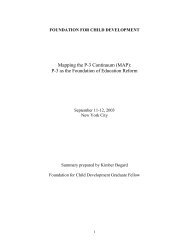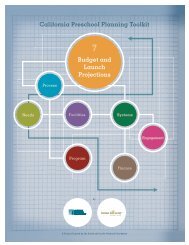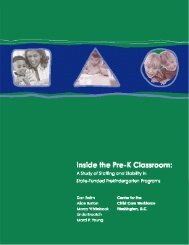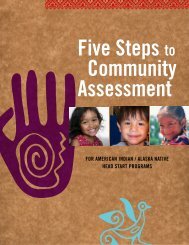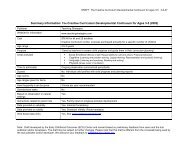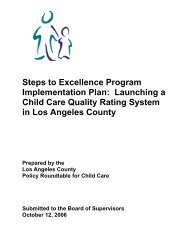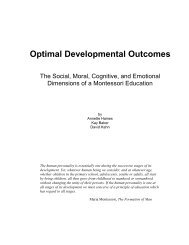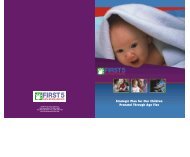Download this file - Plan4Preschool
Download this file - Plan4Preschool
Download this file - Plan4Preschool
You also want an ePaper? Increase the reach of your titles
YUMPU automatically turns print PDFs into web optimized ePapers that Google loves.
FITNESSGRAM ® , designated for <strong>this</strong> purpose by the State Board of Education (SBE).<br />
The FITNESSGRAM ® , developed by The Cooper Institute, provides criterion-referenced<br />
standards to evaluate fitness. These standards represent a level of fitness that offers<br />
some degree of protection against diseases that result from physical inactivity.<br />
Achievement of the fitness standards is based upon a test score falling in the Healthy<br />
Fitness Zone (HFZ) for each of six tasks that measure a different aspect of fitness. The<br />
HFZ represents minimal levels of satisfactory achievement on the tasks. The goal is for<br />
students to achieve the HFZ for all six fitness areas of the physical fitness test.<br />
Senate Bill 896, approved in 1998, required the California Department of Education<br />
(CDE) to compile the physical performance test results by December 31 and to submit<br />
report results to the Governor and Legislature. Statewide data collection is completed<br />
electronically. School districts may submit their data to the CDE through the Internet, by<br />
diskette or CD-Rom, or by e-mail. Physical fitness test results are reported by school,<br />
school district, county, and the state. The results are posted on the Physical Fitness<br />
Testing Web site at http://www.cde.ca.gov/ta/tg/pf. These reports are available by<br />
gender and race/ethnicity. No individual student data are reported on the CDE Web site.<br />
Schools are required by law to include physical fitness test results in the School<br />
Accountability Report Card (SARC) and to provide students with their individual results<br />
(EC Section 60800). The most recent physical fitness data are to be reported, including<br />
the percentage of students scoring in the healthy fitness zone on all six fitness<br />
standards. Data are reported for the state and for each county, school district, and<br />
school for the purpose of comparison.<br />
For more information regarding the physical fitness test, contact the Standards and<br />
Assessments Division, at (916) 445-9449 or by e-mail at pft@cde.ca.gov. Information is<br />
also available on the Physical Fitness Testing Web site at<br />
http://www.cde.ca.gov/ta/tg/pf.<br />
California High School Proficiency Examination<br />
The California High School Proficiency Examination (CHSPE) is a program established<br />
by California law (California Education Code [EC] Section 48412). CHSPE provides an<br />
opportunity for eligible persons to prove their proficiency in the basic skills and earn a<br />
legal equivalent of a California high school diploma.<br />
The CHSPE is given three times each year at approximately 75 sites throughout the<br />
state. Registrants must pay an $85 registration fee. Enrollment in high school at the<br />
time the test is given is not a requirement, but at the time the test is taken persons<br />
wishing to take the test must (1) be at least sixteen years of age; (2) have completed<br />
one year of enrollment in tenth grade; or (3) complete one year of enrollment in tenth<br />
grade at the end of the semester during which the next regular administration will be<br />
conducted. There is no upper age limit to take the test.<br />
The State Board of Education (SBE) awards each person who passes the CHSPE a<br />
Certificate of Proficiency, which is equivalent by law to a California high school diploma.<br />
42



